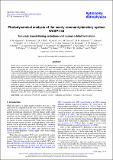Photodynamical analysis of the nearly resonant planetary system WASP-148
Abstract
WASP-148 is a recently announced extra-solar system harbouring at least two giant planets. The inner planet transits its host star. The planets travel on eccentric orbits and are near the 4:1 mean-motion resonance, which implies significant mutual gravitational interactions. In particular, this causes transit-timing variations of a few minutes, which were detected based on ground-based photometry. This made WASP-148 one of the few cases where such a phenomenon was detected without space-based photometry. Here, we present a self-consistent model of WASP-148 that takes into account the gravitational interactions between all known bodies in the system. Our analysis simultaneously fits the available radial velocities and transit light curves. In particular, we used the photometry secured by the Transiting Exoplanet Survey Satellite (TESS) and made public after the WASP-148 discovery announcement. The TESS data confirm the transit-timing variations, but only in combination with previously measured transit times. The system parameters we derived agree with those previously reported and have a significantly improved precision, including the mass of the non-transiting planet. We found a significant mutual inclination between the orbital planes of the two planets: I = 41.0+6.2°-7.6 based on the modelling of the observations, although we found I = 20.8 ± 4.6° when we imposed a constraint on the model enforcing long-term dynamical stability. When a third planet was added to the model – based on a candidate signal in the radial velocity – the mutual inclination between planets b and c changed significantly allowing solutions closer to coplanar. We conclude that more data are needed to establish the true architecture of the system. If the significant mutual inclination is confirmed, WASP-148 would become one of the only few candidate non-coplanar planetary systems. We discuss possible origins for this misalignment.
Citation
Almenara , J M , Hébrard , G , Díaz , R F , Laskar , J , Correia , A C M , Anderson , D R , Boisse , I , Bonfils , X , Brown , D J A , Casanova , V , Cameron , A C , Fernández , M , Jenkins , J M , Kiefer , F , des Étangs , A L , Lissauer , J J , Maciejewski , G , McCormac , J , Osborn , H , Pollacco , D , Ricker , G , Sánchez , J , Seager , S , Udry , S , Verilhac , D & Winn , J 2022 , ' Photodynamical analysis of the nearly resonant planetary system WASP-148 ' , Astronomy & Astrophysics , vol. 663 , A134 . https://doi.org/10.1051/0004-6361/202142964
Publication
Astronomy & Astrophysics
Status
Peer reviewed
ISSN
0004-6361Type
Journal article
Description
Funding for the TESS mission is provided by the NASA Explorer Program. Resources supporting this work were provided by the NASA High-End Computing (HEC) Program through the NASA Advanced Supercomputing (NAS) Division at Ames Research Center for the production of the SPOC data products. Funding for the DPAC has been provided by national institutions, in particular the institutions participating in the Gaia Multilateral Agreement. A.C. acknowledges support by CFisUC projects (UIDB/04564/2020 and UIDP/04564/2020), GRAVITY (PTDC/FIS-AST/7002/2020), ENGAGE SKA (POCI-01-0145-FEDER-022217), and PHO-BOS (POCI-01-0145-FEDER-029932), funded by COMPETE 2020 and FCT, Portugal. G.M. acknowledges the financial support from the National Science Centre, Poland through grant no. 2016/23/B/ST9/00579. MF acknowledges financial support from grant PID2019-109522GB-C5X/AEI/10.13039/501100011033 of the Spanish Ministry of Science and Innovation (MICINN). M.F., V.C. and J.S. acknowledge financial support from the State Agency for Research of the Spanish MCIU through the Center of Excellence Severo Ochoa award to the Instituto de Astrofísica de Andalucía (SEV-2017-0709). J.M.A. and X.B. acknowledge funding from the European Research Council under the ERC Grant Agreement n. 337591-ExTrA.Collections
Items in the St Andrews Research Repository are protected by copyright, with all rights reserved, unless otherwise indicated.

